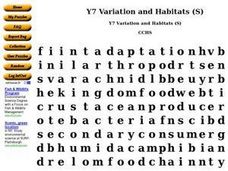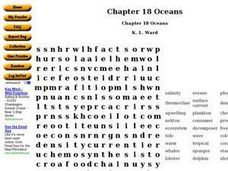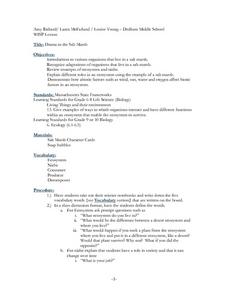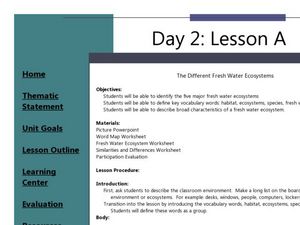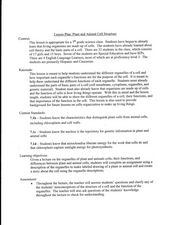Curated OER
Science Crossword Puzzles: Life Science
Review some simple life science terms using this short and simple crossword puzzle. Young scientists find 6 terms about photosynthesis and other life science topics using provided clues and then plug them into a crossword.
Curated OER
Water Quality Monitoring
Learners study the water quality of a stream in their area, by measuring the temperature, pH, alkalinity and conductivity. They integrate biology with earth science when using the microscope to study the living organisms in the water.
Curated OER
Biome EcoWatch Project
Students work together to complete the Biome EcoWatch project. Using the Internet, they research the relationship between abiotic factors and living organisms within a biome. They create a multimedia presentation to share their...
Curated OER
Blocks And Screws (or "screwy Contrivances")
Young scholars, given a block of wood and a screw or nail, are asked to put that screw or nail into a block. They examine how many contrivances and other imperfections found in living things are best explained by the process of evolution.
Curated OER
Nature Notes
Students spend some time outdoors and record their observations of abiotic conditions, geologic surroundings and living organisms. They reflect and write about the experience of being observant in nature.
Curated OER
You Belong in the Zoo Project - Using HyperStudio
Learners explore the diversity of living organisms. They research an animal found in the zoo and plans a 10-card HyperStudio project about his/her organism.
Curated OER
Classification
In this biology worksheet, students identify and locate various vocabulary terms related to the classification of living things. There are 32 biology terms located in the word search.
Curated OER
Y7 Variation and Habitats (S)
In this biology instructional activity, students identify and locate various vocabulary terms relating to variations and habitats of living things. There are 37 biology terms located in the word search.
Curated OER
Chapter 18 Oceans
In this earth science worksheet, learners identify and locate various vocabulary terms pertaining to the ocean and living things found in the ocean. There are 27 ocean terms located in the word search.
Curated OER
Catering Middle-School Science: Monomers, Polymers, and Macromolecules
Students investigate foods. In this biology lesson plan, students will conduct testing on different types of foods as they learn about different molecules that make them up. Students will also learn about the shapes of the molecules.
Curated OER
Introduction to Classification
Fourth graders design a classification system to categorize animate and inanimate objects. They discuss the advantages of grouping things as they classify buttons, leaves, shells.
Curated OER
Drama in the Salt Marsh
Students are introduced to the various organisms that live in a salt marsh. They recognize adaptations of organisms that live in the salt marsh. Pupils review concepts of the ecosystem and niche. Students explain the different roles...
Curated OER
Vermicomposting
First graders investigate composting. In this biology lesson plan, 1st graders identify ways to use garbage as fertilizer. Students examine soil and compost matter as well as the role of worms in the dirt.
Michigan Sea Grant
Fish Identification
Using a dichotomous key, pupils identify characteristics of fish who live in the Great Lakes and explain how these features help them survive. In small groups, class members discover what features scientists consider important and...
Curated OER
Food Chains and Food Webs
In this biology worksheet, students read about food chains and food webs. They then answer 4 questions regarding the information they just learned. The answers are on the last page in the packet.
Curated OER
The Gift of Life - Day 2: "Cell & Organelle Time to Tell" and "World in Color" (Chapters 2-4)
Students complete a cell biology lesson and a color lesson based on The Giver. In this biology and reading comprehension lesson set, students examine cells using microscopes. They look at the organelles and listen to How Much is a...
Curated OER
What Makes a Cat a Cat?
Learners investigate the lives of pets by videotaping them. In this animal life lesson, students videotape a cat and other pets using school cameras in a computer lab. Learners review the footage from the cat and other animals and...
Curated OER
Cell Parts
In this biology worksheet, students read about the parts of both plant and animal cells and examine cell diagrams. They read about the function of cell parts before answering 11 online fill in the blank questions.
Common Sense Press
What is the Skeletal System?
Students investigate the human skeletal system. For this biology lesson, students trace the outline of their body onto butcher paper and fill in the names of the bones. Students use an overhead transparency of the human skeletal system...
Curated OER
Endangered Species: Not Only Animals
Students research endangered animals and plants. In this biology activity, students are read Will We Miss Them? Endangered Species by Alexandra Wright before they begin searching for information to complete an endangered species...
Curated OER
My Colorful Food Chain
Students explore biology by participating in a dietary habit activity. In this food chain lesson, students discuss their own diets and the animals we feed upon daily. Students create a poster demonstrating the animals that we feed upon...
Curated OER
Exploring Learned and Innate Behavior
Compare and contrast learned and innate behaviors between humans and primates. Your biology class members read articles and participate in discussions about the use of tools and communication methods. That's about it, you'll probably...
Curated OER
The Different Fresh Water Ecosystems
Students summarize the characteristics of an ecosystem. In this biology instructional activity, students identify five major fresh water ecosystem. They define terms and write a journal about what they learned.
Curated OER
Plant and Animal Cell Structure
Seventh graders identify the different parts and functions of the cell. In this biology lesson, 7th graders make a labelled diagram of either a plant or animal cell. They write a story about it.









